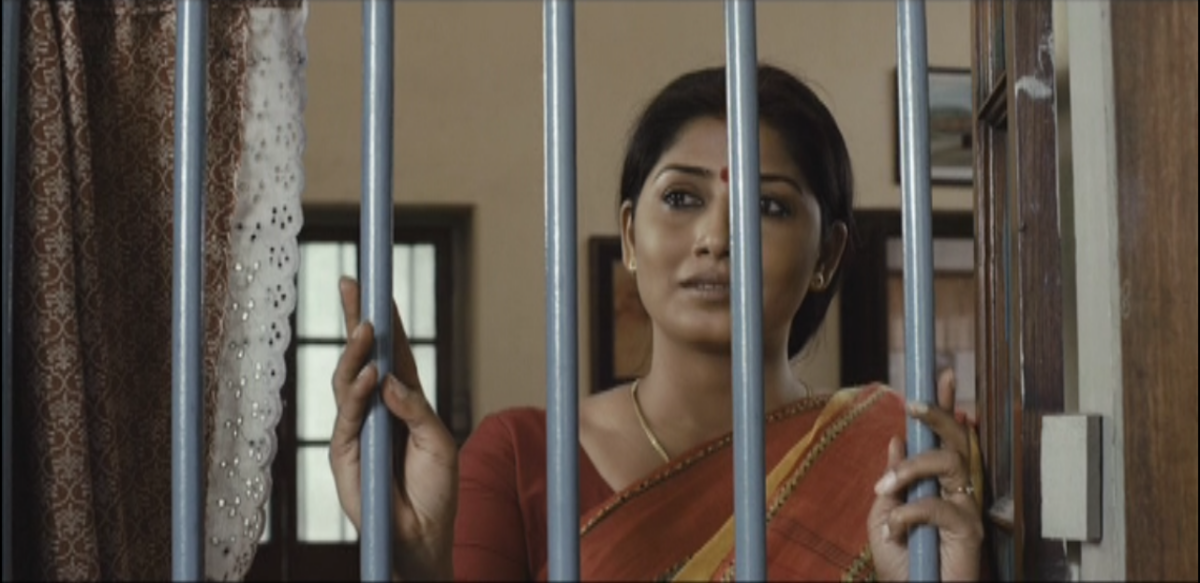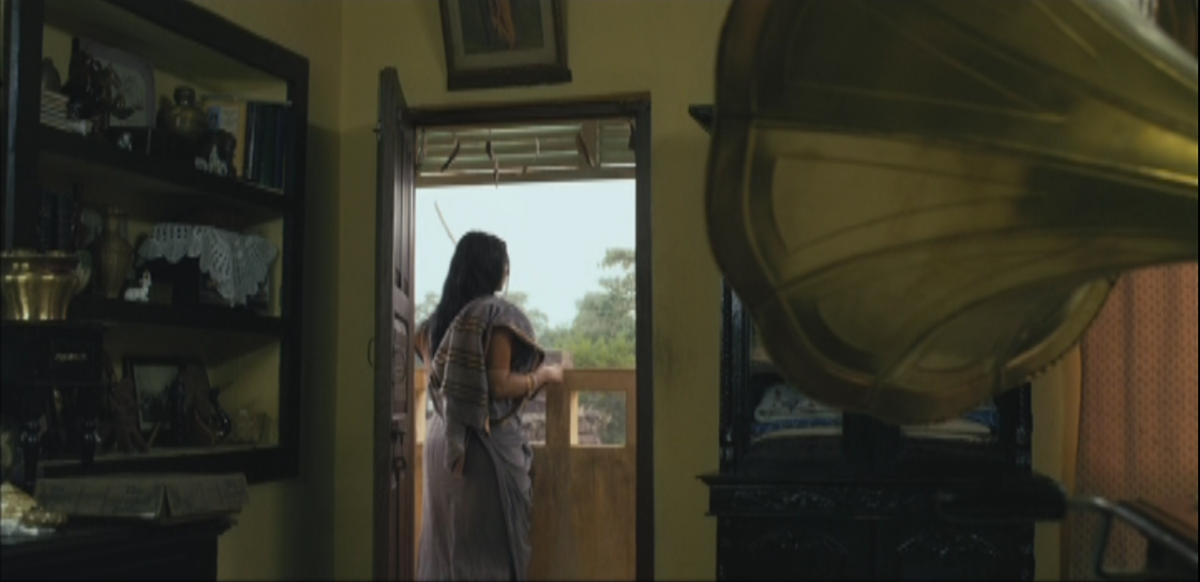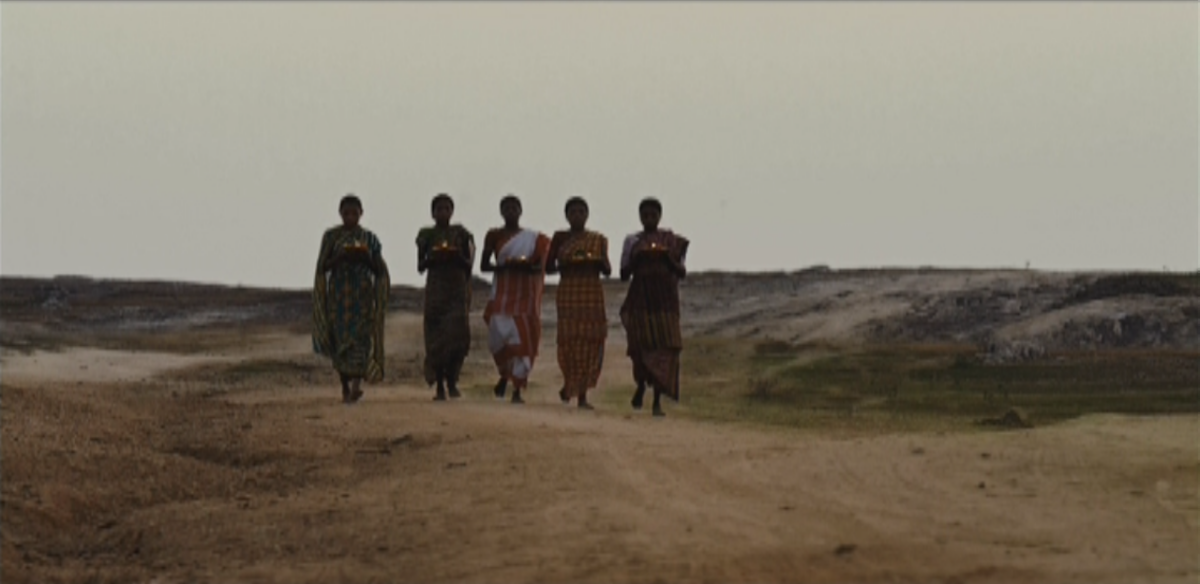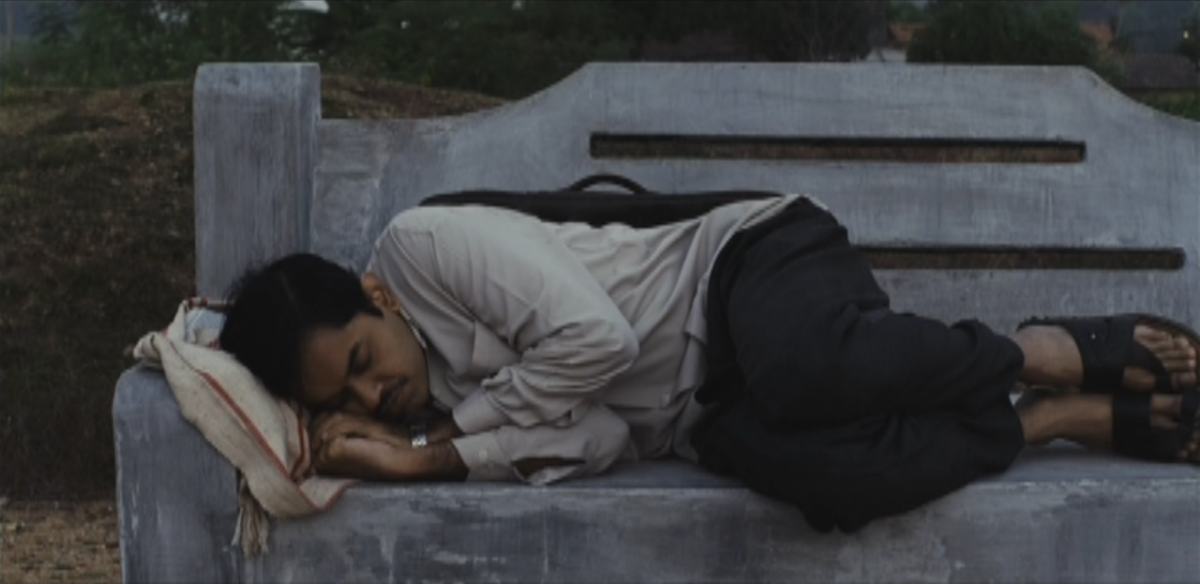In 2012, Indian filmmaker Buddhadeb Dasgupta created an anthology of 13 short films called Trayodashi. The shorts, based on 13 poems by Nobel prize-winnerIn 1913, he became the first non-European writer to be awarded the Nobel Prize for Literature for Gitanjali: Song Offerings, the English translations of his Bengali prose. Rabindranath Tagore, were commissioned by the Ministry of Culture and Ministry of Information & Broadcasting in India to commemorate Tagore’s 150th Birth Anniversary, and telecast on DoordarshanDoordarshan is an Indian public service broadcaster founded by the Government of India, owned by the Ministry of Information and Broadcasting..
To the world, Rabindranath Tagore is known as a poet extraordinaire; but in India, his cultural significance looms large. As a writer (of poems, plays, songs, stories, operas and novels) he reshaped Bengali literature, music and art and ushered in an era of Modernism in Indian Literature (of the 20th century.) Hailing from a family of immense wealth, and social influence, he took up the task of social reform and remained committed to his people. He built institutes, and nurtured the arts. Santiniketan, a town built by his father, Maharshi Devendranath Tagore, was expanded by Rabindranath into a university town, modelled on his vision to create an abode of learning, convened with teachers and artistes from all over the world. Rabindrantha Tagore wrote tracts and essays inspiring the lot of society; on issues advocating for the rights of women oppressed by religious orthodoxy, and towards instilling a spirit of resistance and nationalism during India’s freedom struggle against the BritishFor a short but comprehensive introduction to Tagore and his significance in India, watch Satyajit Ray’s remarkable documentary on Tagore, produced by the Films Division, India.. What more testifies to Tagore’s place in Indian history than the fact that India’s national anthem—Jana Gana Mana—is written by Tagore.
However, it is not for Tagore’s influence that I have chosen to write about these films. For an issue on Idle Cinema, it was imperative to write about a work or form that had managed to free itself, if not transcend, from the limits of taut structures. A form that explored a break from an urgent and specific contemporarity, and encouraged an abstraction in thought, image and language. Poetry is that form.
Secondly, the usefulness of these shorts is not solely because of their faithful verse-like adaptation of poetry itself, but because on their own accord, as short films, they advance on the concerns of this publication, namely: subversion of the obsession with narrative, rationality, or meaning making—all of which extend to the notion of a machine-like utility or productivity, against which this issue is a call.
These short films are as much a creation of Tagore’s as they are Buddhadeb Dasgupta’s. Dasgupta was a poet-filmmaker, with an equally ingenious corpus in each form. He was a renowned Indian filmmaker, popularly called the “chronicler of dreams”, for his choice of stories of ‘misfit’ characters, told through their dreams, fantasies, or idiosyncrasies. What distinguishes him, from fellow Bengali stalwarts like Satyajit Ray and Mrinal Sen, who were at the peak of their careers when Dasgupta began making films, is his turn away from realism into an original style of filmmaking characterised by sparse dialogue, distinctive minimalism, and shades of absurdity, surrealism or open endedness. Be it the story of the village tiger-dancer man (Bagh Bahadur, 1989), a cautionary tale on communal violence told through the homoerotic sport of wrestling (Uttara, 2000) or commentary on the refugee crisis in East India told through the search for a lost government projector (Swapner Din, 2004). The four shorts which I have selected for this essay are no different. Each one challenges some notion of our prescribed social existence—the happy lives of nice girls (The Flute Player), the life of the exploited/victimised sex worker (The Pond), as well as the broadcast viewer’s expectations—of coherence, or a consumable message (ideally for social good) (Istition) or a neatly presented closure (The Dark Maiden). All of this is achieved, cinematically, not by dialogue or a linearly constructed narrative, which would ultimately fall into the same trap of instruction, but, rather, by suspension. In each short, whenever the viewer is tempted to pin-down the message of the film to realism, Dasgupta throws a curveball, throwing the entire meaning-making exercise down a cliff. This commitment to suspend meaning, and expectation, and push, instead, towards an imagination of a different way of being, through representations of alternate occupations, or idleness, insanity, or dreaming, recklessness—is an essential quality of Dasgupta’s cinema, and perhaps, his political statement, in a country, obsessed with notions of purity and virtuousness, and a local cinema culture (Bengali) driven by didacticism. The shorts are discussed in the light of this argument.

The Flute Player
The first short in the quartet is Banshiwala (The Flute Player). It is the story of Shanta, a young housewife of an affluent Bengali household, whose inner desires and dreams conflict with her coarse realities. Dasgupta, in his distinctive style, responds to crude violence/oppression with art, softness and fantasy, giving us a deeply layered and unsettling film in the garb of an ordinary housewife’s tale.
Shanta’s make-up ritual is synced to the sounds of the morning birds. She’s applying alta on her feet, putting on her anklets, vermillion, tying her hair in a bun. We hear the tinkling of her ornaments, and watch her elegant gestures. There is little vanity or romanticism in her movements. The cooing of the birds is disturbed by the snoring of her husband. Right at the onset, the incompatible nature of the marriage becomes clear. The camera takes care to present the jerking, naked, hairy, bulging belly of the husband and his repugnance as an artless contrast to her delicate femininity. It is a regular day.
Suddenly, a dissonance steeps. She escapes into another space. She’s walking on water. Slowly, gracefully, she takes one step after another. All the care she just took to tie her hair and tightly crease her saree is getting undone, yet she seems unbothered. She’s walking into the water with intent. Now, there’s a startle. It was a dream. She gets up and gets on with her day. But something remains unfinished, residual emotions linger on.
As her day unfolds, so do the facets of her life. She’s not involved in grueling chores, but she follows a closely monitored schedule of tending services to the needs of the family members. “Shanta, hurry, serve the food,” orders her husband from one end. “After lunch is served, come, massage my feet,” commands her mother in law. She fulfills her duties, and is rewarded for them through their self-praise. Her husband puffs his chest, and boasts that “the happiest man on earth is one whose wife is a good cook”. Her in-laws are proud of having found the “nicest girl” through their careful scrutiny from a sea of proposals. Beyond these self-congratulatory remarks, there is no other conversation between them. We never see her smile when she is around them.
When Shanta is able to catch some respite from her work, she confides in her pet parrot, Mitthu, her only companion, who, much like her, is caged. “I feel disgusted when someone calls me nice. Because I wonder, would they still call me nice if they knew the real me?” she shares. “If I had wings like you, I’d fly away. Just anywhere, wherever I like… I hate to follow rules,” she declares. It is through her exchanges with him that we learn about her emotions, her psychological state, and the inner life of the ideal daughter-in-law.
What is it that Shanta, so vehemently, wants to run away from? For generations, the lives of women like Shanta have been preordained for them. At a young age, girls are bound into traditionally arranged marriages by their parents. For families of the groom, the daughter-in-law, is little more than free labour. These girls spend their whole lives, trapped, in loveless marriages because they have no choice. They are conditioned to expect nothing more than a provider, and locate their happiness, purpose or fulfillment in self-effacingly birthing and raising children. In a society thriving on violence, abuse and disenfranchisement of women, Shanta’s joyless life seems pretty ‘normal’. So much so that, to those who conform, even the idea of something so normal/normalised causing her such profound grief and dissonance that she wishes to run away, seems crazy.. When the answer lies in possessing the right to freedom. Dasgupta complicates this debate on normalcy and rationality, by giving Shanta a rich, and lucid inner life of dreams and fantasies, at sharp odds with her coerced reality.
Her object of desire is the flute player. A mysterious figure. He is somebody, who appears, as though in a vision, through the hours of the day, and night, whenever Shanta is distressed. She watches, through the bars of her window, like a prisoner, and is soothed and charmed by his tunes; she smiles then. He is a man, with a young gait, walking into deep woods. We never see his face, but she tells Mitthu he has big eyes, and is very handsome. It is his figure who ignites the fire to seek adventure in her. When alone with Mitthu, she doesn’t complain of her husband’s indifference, or wishes he loved her. She divulges her fantasy to run away with the flute player, a strange man she has never met, to dive into the full spectrum of uninhibited human experience? Dasgupta’s heroine does not wish to fit in.
The film moves rhythmically between these three spaces—Shanta’s domestic ‘reality’, her dreams of submerging in the ocean, and the ‘in-between’ zone where the flute player comes and goes. With each dream, she has moved further away from the shore into the ocean. Each time, she has escaped a little more. There is also another sequence in which several mementos of man-made time—historical mementos, ticking cloths, books, scriptures, transistor radio, etc. fly in thin air, in front of her, as though to caution and pull her back to reality. Amongst all these moments, the only times she smiles are when she’s dreaming, when she’s speaking to the parrot, and when she’s alone playing with trinkets. If it were a film promoting practicality, or conformism as choice, it would have ended with Shanta drowning or willingly submerging into the ocean, her recurrent dream, staging symbolic death by oppression. But in the end, we see Shanta having escaped the bars to follow the flute player. We do not know if she really escaped, or if it were a dream. All we see is Shanta look back towards the camera, and once again, for the last time, smile.
Through these associations, the film implicitly comments on the crudest patriarchal anxiety about ‘nice girls’ eloping with men from the outside, and also on the stifling nature of physical, emotional and sexual labour drilled out of women under the garb of tradition. It also suggestively targets the darker violence of repression and marital rape. But at the heart of it, it is a story about a woman seeking choice, and agency for herself; craving adventure, thrill, a sense of anonymity or individuality, and simply the right to be wrong. This idea is so ridiculous to patriarchal society that if the presentation of it seems to end up becoming a script for a crazy housewife, then for Dasgupta, so be it.

The Pond
What are a common viewer’s expectations from a short about a pond? To outline a canvas, the standard ideas could range from its historical significance, its ecological condition, or related to its impact on local social relations. Dasgupta’s pond isn’t about any of those themes, but a completely unrelated fourth thing, in fact, it doesn’t seem to be about the pond at all, as we subsequently learn.
When the short opens, we see a middle aged, village cyclist swiftly set up his spot across the shore. He is carrying many articles—puts an umbrella out for shade, takes out a basket and a fishing rod. He seems to be here for a purpose. But contrary to expectation, he starts reading a book of love poems instead of fishing. Somewhere not far from him, a university student/poet-type character walks to the lake. Sitting away from the cyclist, writing and loudly reciting love poetry (the only bit of ‘dialogue’ in the whole film), oblivious to the surroundings. The cyclist looks at him annoyed. As the viewer is beginning to settle, the scene’s setting shifts.
It is a woman’s bedroom. She is middle aged, but strikingly sensuous, and seems to be well aware of her attractiveness. Wet hair, kohl-eyed, admiring herself in the mirror seductively. Unlike Shanta, she isn’t in a hurry to get dressed. She’s taking her time, trying out ways to style her hair and her saree pallu. Her expression is relaxed, coquettish. She is enjoying herself. Can’t decide what to do, finally decides to let her hair air dry. Very unlady-like. She takes a pair of binoculars out of her dressing drawer and stands on her balcony to watch the outside world. In the house next door, a young unmarried girl, with two unfashionable braids, is begrudgingly taking dried clothes off the rope. She quickly finishes her work, notices the woman watching her, gives her a look and rushes back inside. The girl is, understandably, irritated because she has chores, but the woman seems unbothered. The presence of this young girl doing chores is only to emphasize the stark contrast of the woman’s demeanour and routine—carefree and chore-less. Our lady with the binoculars moves her gaze to the pond. The cyclist is now involved in a new game. He catches a fish, and then throws it back into the water. The young writer is still writing love verses. There is another man catching fish. The deficit of momentous activities on the pond, contrasts the budding momentum inside the woman’s bedroom, making it clear, albeit unexpectedly, what the focus of the short is. As the verse at the beginning of the short prefaces, ‘The Pond’ is about the perspective from the two-storeyed building, which looks out to one corner of the pond.
The lady’s hair is still untied, which is unusual for a housewife who has to tidy-up and finish chores. Hair let loose is a sign of leisure, of promiscuity. She puts on a vintage record. Ghulam Ali is now singing Ali, ‘Ka Karun Sajni”, about a girl describing her longing for a lover who has not returned. The choice of music is suggestive. An Indian viewer would be alerted about the historically close associations between Indian classical musicians, and the nautch girls of the earlier generations. All doubts are dispelled as the woman’s next actions unfold. She is prancing across the room, blowing kisses, playing with her hair; a new act, a new expression, each time she walks by the mirror, as though she’s enacting a Kathak movement. And then comes the most seductive act of all. She starts peeling and eating a banana, and finishes it off in two bites. One after another, she pulls them out of the bunch, all the while looking at herself in the mirror. She is a sex worker, operating independently out of a storied building—another reference to the trade. All this while, the ongoings at the lake are at a standstill, because it takes this woman’s perspective to show us what is happening out there, and she is in siesta mode. Now resting on the bed, fanning herself, and playing with a pussy-cat. It is almost as though the viewer is enslaved by her. She is not under any man’s time. She is in control of what she wants to do and what she wants to show. Only that will be seen. Tired of doing nothing all day, she falls into a deep afternoon slumber. What a scandalous film for the broadcast viewer. What a fabulous life.
Watching this woman do zero chores, have no husband or in-laws to serve, especially after the powerful but distressful last short on Shanta’s life, one does not help but wonder if this was Dasgupta’s take on what it’s like to live a life not controlled by any patriarchal authority or under their gaze? And is the life of a happy sex worker the alternative to a life of an unhappy housewife? The short raises some tough questions. The lady is anything but the image of the sex worker as a victim. Beyond the hegemonistic notions of a life wronged or a life of exploitation, it seems to be a life where freedom is enacted through every movement of the body. The scene is devoid of any stereotypes or easy associations with the dancing girl. So, one could be mistaken in their interpretation of the housewife as a ‘hooker’, but there is far too much going on to ignore. When the sun sets and everyone on the pond departs for home. Our woman, at last, ties her hair in a neat bun, puts a vermillionMarker of a married Hindu woman., and opens her door to a visitor, we never see. She is standing on her door, giving welcoming looks.
Only a filmmaker like Dasgupta could paint such a novel and radical portrait of a day into the life of a dancing girl, with such intimacy, poetry, and beauty, under the pretext of a silly pond scene, and shock the viewer, once again, out of their wits.

The Dark Maiden
The Dark Maiden is like two seemingly disconnected shorts combined. One part of the short is the classic tale of a writer, and his muse. He falls in love with a maiden he meets in the countryside, writes a book about her, and spends years searching for her. Do they unite at the end? Or was it all a dream? These are some questions the viewer is left wondering.
A tall, handsome long-haired traveller is lost. His car breaks down. He is simply walking around, observing the scenery like a tourist. The plastic nature of his position in that landscape is underscored by a village belle rushing onto our screen in urgency, looking for her two black cows. The urban traveller is mesmerised by the dark complexioned, rustic beauty—her doe-like eyes, slender limbs, luscious hair, smile and carefreeness. Next thing we see, the car driving into the horizon, into a pink sunset, with romantic verses about soulmates being recited in the background. Like any standard romance, the assumption is that the urban traveler has rescued the young virginal maiden and is taking her to a life of social mobility, and comforts that she had only dreamt of. This is the fairytale that the bourgeois viewer wants and expects. But a reiteration and solemnisation of colonial and heteronormative setups through ritualisation of a union is the last thing to be expected of a Buddhadeb Dasgupta film. For the second part of the short, and the most joyous part of the film, comes now.
For almost seven minutes (of a 20 minute short), on the same countryside road on which the ‘hero’s’ car just passed, becomes the passage on which a trail of men and women walk by. An array of people, one after another, in pairs or solo, with utilities and curiosities—mask seller, village drummer, vendors, mystics, a bullock cart, even the flutist from the previous short pass by. Nothing else happens, just people walking in their own paces—people, rooted, and more suited to that ecosystem of the countryside. All synced to an aesthetic rhythm, these are the characters who comprise the universe of Dasgupta’s films from Bagh Bahadur, Uttara, Swapner Din and others. This seven minute scene breaks the monotony of narrative drama. Dasgupta wants the viewers to watch what is happening on screen—even if it means watching things of ‘no consequence’. The randomness of this whole scene—its appearance, constituents, and duration—is anti-colonial, anti-Bollywood, and anti-climactic, for it does not contribute to the ‘main narrative’. But there is no hierarchy of narrative in Dasgupta’s films; his foremost commitment is to subverting the generic frameworks. Commercial films tend to centre around the romance between two characters, pushing everyone else into insignificance, the kind of filmmaking Dasgupta seems to be fiercely against. The short is anti-colonial because in a story about the dark maiden from the countryside, the setting of the countryside cannot simply be a prop, or reduced to a space to advance upon an imperial, urban narrative. Thus, the figures on the screen represent the natives of the place, which walk on the road, the urban cars drive by, everyday, and showcasing just their walk is a statement.

The Station
A man in a great rush, arrives at the railway station. He misses his train to Calcutta (now Kolkata). It is night time, and he learns that the next train isn’t till early morning the next day, and there is no hotel around to spend the night. The gentleman (genteel according to Bengali ‘bhadralok’ (bourgeois)) is forced to spend the night at the railway station, where he encounters and interacts with three outcasts—an old beggar, a sex worker and a young thief. When his train finally arrives the next morning, he is fast asleep from last night’s adventures and misses it once again. His friends from last night have vanished.
These three figures are an unrecognised part of our economies, their labours are considered ‘unlawful’ and, thus, they remain at the margins of our capitalist societies. In the minds of our casteist middle-class society, these presences are more immoral labels than real people inhabiting a precarious livelihood or existence. Dominant narratives in popular culture around these figures are told from a colonial and casteist lens. A beggar, a thief, or a sex worker are either out to con you, or in a need of saviour. Representations of these marginal figures also tend to happen through the lens-based invasion of an upper-class, upper-caste figure into their spaces, their lives. In Dasgupta’s short, the interaction between a genteel man, and the ‘others’ is a chance occurrence, which makes it interesting. It is the space where all of them meet. A railway station is an example of the pinnacle of man’s greatest innovation. During the day, there is a big hustle bustle with people engaged in civil and civic activities. However, at night, the same site becomes the space for activities sacred and profane, mixing elements stable and displaced. In this dark, empty midnight station, the relations of power are overturned, the genteel man becomes the misfit. These creatures of night own the power. He is vulnerable. It is their time to come out to work (and play). However, each one, instead of extracting something from the genteel man, gives him a perspective into the lives of liminality. The beggar never asks the man for money, instead shows him generosity by offering to share his food, which he pulled from the dumps (the leftovers of a grand feast by a man who remarried for a son). The sex worker wastes her night’s wage, giving him company, talking about her husband and son. The young thief, assured of his father’s love, and driven by the will to take the family business forward, ends up gaining an honest buck, not by stealing but through a deal made with the gentleman.
The stories of the beggar, the prostitute and the thief, evoke several emotions in the man, and the viewer—disgust, pity, compassion, amusement, reflection, and introspection. However, there is no aid or utility they perform in the journey of the ‘hero’—they do not help him catch his train, or give him directions to his destination. The bourgeois man doesn’t perform penance or reformation either. The prostitute, the thief or the beggar are not reformed at the end of the discussion to turn away from a life of criminality into becoming good servants of state. Their meeting is incidental, like fellow travellers, which is not usual, between people from different socio-economic sectors. A beggar, a prostitute or a thief, do not comprise his social circle. So, this setting of a dialogue between individuals from different worlds, implies a break from routine, implies a break from social apparatus, and missing the train, becomes that act of deviance which triggers this break in order. The whole purpose, then, of missing the train is only, so, the man listens to stories of people inhabiting liminal spaces, lives considered taboo. An experience, he would have otherwise, never wilfully taken.
Once again, when one gets too close to pinning down the ‘meaning’ of the whole exercise in inclusion, Dasgupta throws a signature something, There is another character whom the gentleman encounters at the railway station, and he is a man of most intrigue. He is a man who lives in the passage under the railway station, but he doesn’t look destitute like a homeless man. He wears a clean set of shirt and pants and carries a suitcase. When the gentleman tries to approach him for help, he is rudely gestured to stay away. Not as violence, but sheer disinterest and indifference. We do not know where he came from, we do not know where he goes. But we see him carefully preparing his bed at night, undressing, spreading down his sheet and peacefully sleeping. The next morning, his unhurried movements of preparing for his day ahead, combing his hair carefully looking into a mirror, all tools intact, is a striking contrast to the eventful pace of the last night, or even to his surroundings. What does he do? Who is he getting ready for? Where does he fit in? We never know. As the railway station assumes its sense of urgency and rat-race, his detachment is a foil to any sense of logic, and punctures the construct of man-made time. The same time, the anxiety of which made the gentleman miss his train the first time, and made him miss it again, as he gets overpowered by the most elemental of human needs—his sleep.
